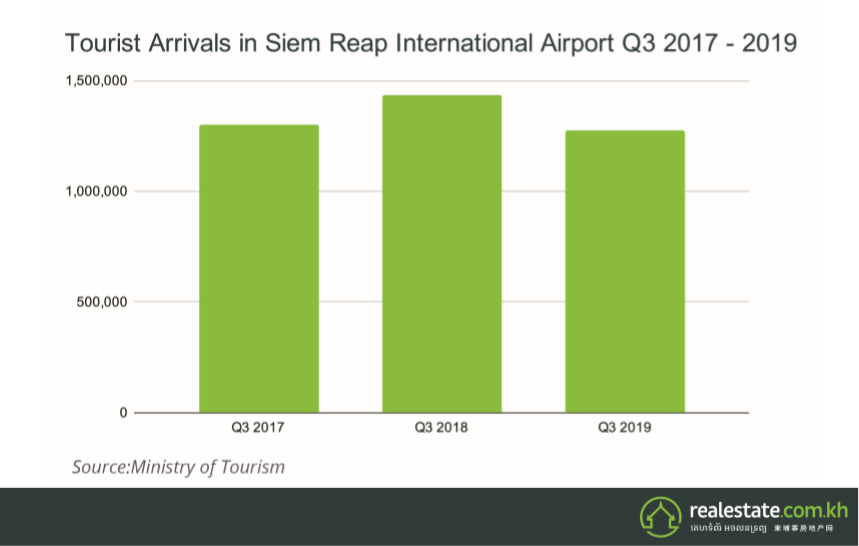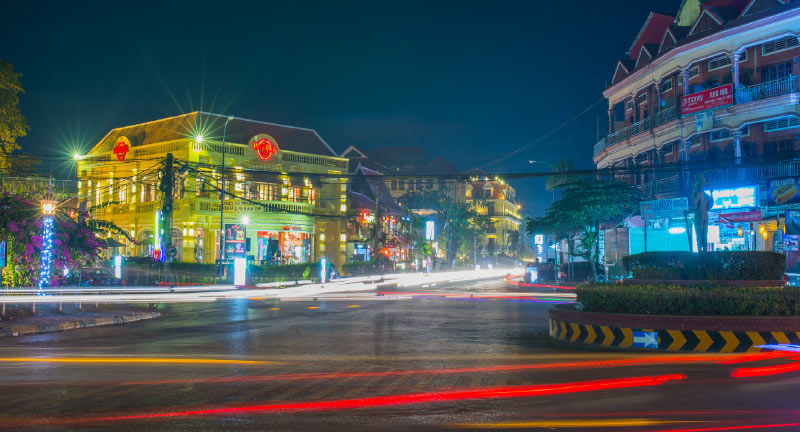3: CAMBODIA REAL ESTATE SECTOR OVERVIEW
3.5 KEY INVESTMENT AREAS: SIEM REAP

Siem Reap is located about 314 kilometres northwest of Phnom Penh, connected by National Road 6. Siem Reap is divided into 11 districts with one central town and 13 sangkats, including 87 communes and 921 villages. The population of the province is approximately a little over 1,000,000 residents, according to the General Population Census 2019.
The province is home to the Tonle Sap Lake, the largest lake in Southeast Asia. This vast waterway was deemed the first Biosphere Reserve by Unesco in 1997, due to its rich biodiversity and in order to promote sustainability in the region. This area is also home to many Vietnamese and Cham communities living in floating villages around the lake.
Phnom Kulen National Park is also located in this province, approximately 48 kilometres from the city centre. It attracts visitors to its two waterfalls and the “river of 1,000 lingas”, a carved riverbed abounding with unique insights into the 900 BC culture which created it. Given its cultural heritage and ecological features, Siem Reap is a key contributor to Cambodia’s overall tourism industry.
The province’s Angkor Wat temple complex has turned Siem Reap into a world-renowned travel destination, with over one million international visitors per year. The Siem Reap International Airport is the second biggest airport in the Kingdom and it has, as of Q3 2019, accommodated over 1.2 million international visitors. For comparison, the entirety of 2018 accommodated 1.4 million international visitors. We can project that the number of visitors this year will break the cumulative 2018 figures by the end of 2019.
In October 2016, the Cambodian government signed an agreement with China’s state-run Yunnan Investment Holdings to build a new $880 million international airport to serve Siem Reap. Construction has already commenced, and approximately $500 million will be spent on the first and second stages of the airport, while the final phase will cost an additional $300 million. Once finished, the airport will have a maximum handling capacity of 10 million passengers per annum. It is estimated that construction will take up to five years to complete.
In terms of residential space, Siem Reap does not have any major condominium developments in the pipeline. Rather, development has been focused on the tourism and hospitality sector. Tracking hotel development in the city is a challenge in itself as hotels open and close on an almost monthly basis, mainly among boutique hotel establishments. According to Knight Frank, there are currently 4 hotels with more than 50 keys in the pipeline with 740 keys across the board. This figure, however, does not include boutique hotels under construction.

Knight Frank’s research logged a total of 11,848 keys across 85 hotels in Siem Reap - about 139 rooms average per hotel as of the first half of 2019. The upcoming total hotel stock in Siem Reap is classified and composed accordingly: Luxury & Upper Upscale (58%) and Upscale & Upper Midscale (42%). Knight Frank has not recorded any Midscale & Economy hotels in their report.
Visitors to Siem Reap, however, are beginning to see a moderation of sorts. Tourist growth has stabilized at 5.4% year-on-year. According to data from the Ministry of Tourism, almost 40% of tourist arrivals in Cambodia are from China while tourists from Western countries are on a steady decline.
Knight Frank’s H1 2019 Real Estate Highlights echo this shift in tourist demographics. Interested investors in Siem Reap’s hotel sector are advised to examine the landscape of current tourist demographics, and their preferences, before venturing into the city’s highly competitive hospitality market.
While the competition in the hotel sector mainly serves tourists in the region, a new market is developing to serve those seeking to live in Siem Reap. The city’s record in mass residential development has been slow at best for the previous decades. It was only in the past few years that developers have taken interest in Siem Reap’s residential development potential.
The Siem Reap residential market is substantially less dense than that of Phnom Penh. Villas, shophouses and low-lying apartment buildings remain the norm. Large scale apartment or condo construction is limited in Siem Reap due to protective caveats around airspace anywhere near the temple complexes. However, this trend is beginning to shift with more launches entering the market this year. Borey development on the outskirts of the city is also an emerging theme, as more Cambodians move to live and work in the province, and Siem Reap locals move from homes in the downtown area to make the most of higher land prices.
According to Knight Frank, Borey Tourism City, a borey developed by OCIC, is the largest existing project with more than 60 hectares of land area. The project offers single villas, twin villas, and flat houses as well as leisure facilities. OCIC seems to have struck gold as all their units were sold out in their first and second phases.
Other major projects such as Les Bijoux D’Angkor, Borey Angkor Palace, Bakong Village, Angkor Grace, and Vnom Empire are still under development in Siem Reap. Land prices in Siem Reap are driven mainly by the commercial value based on the tourist traffic in Siem Reap. Prices are also influenced by the strict enforcement of zoning restrictions in the Apsara Zone (land around the temples) which drive property development towards the outskirts of the city.
The increase in tourists and permanent residents, presents a ripe opportunity for retailers planning to enter Siem Reap. Shophouses and small scale markets continue to line Siem Reap’s main roads to complement tourism activities. But these traditional retail forms are slowly facing competition from purpose-built malls - which shows an interest in the local market for something new.
According to Knight Frank, Siem Reap currently has 22,000 sqm NLA of retail space, mainly coming from T Galleria, Angkor Duty Free, and The Heritage Walk. The completion of other projects in Siem Reap is set to increase the cumulative retail space to 70,500 sqm NLA.
Siem Reap has been known to be an international tourist destination for a long time. But data shows that Phnom Penh is starting to edge Siem Reap in terms of international tourist arrivals and we can view this as a need for diversification in the city’s offerings.
The interest to make Siem Reap more than a tourist destination is taking shape through how keen local buyers are in borey developments, and the curiosity of the local market in purpose-built retail malls. Not to mention, Siem Reap is the 2nd most populated city in Cambodia, that population is complemented by over 1 million tourists each year looking to bring something of Cambodia back with them.


- Introduction
- Covid 19 Economic Effects
- Cambodia, A Final Frontier: The Opportunity in Sum
- 1. About Cambodia
- 2. Foreign Property Ownership Mechanisms
- 3. Cambodia Real Estate Sector Overview
Add as Favourite
Please fill personal info before saving favourites. Open Profile Settings.





